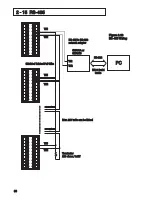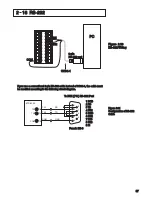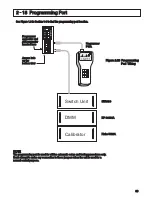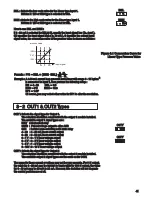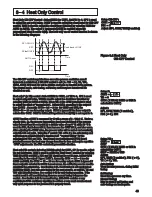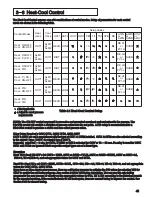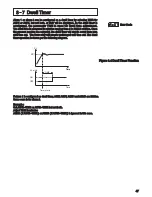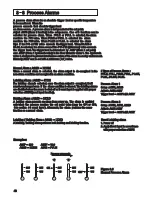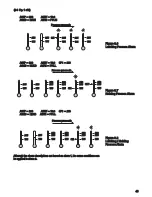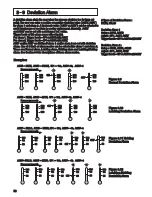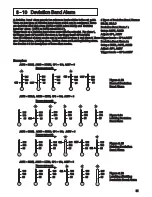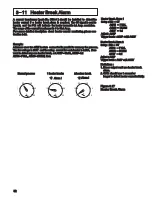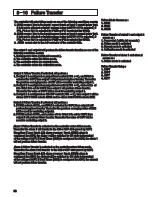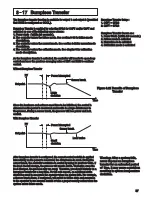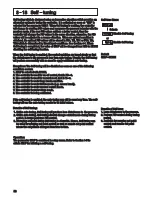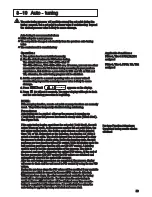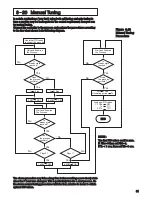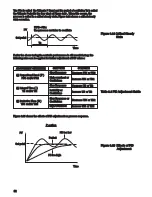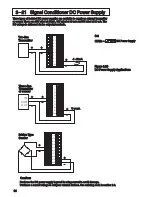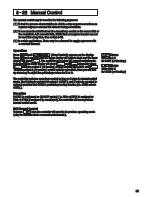
3 9 Deviation Alarm
3 9 Deviation Alarm
A1FN = DE.HI, A1MD = NORM, SP1 = 100, A1DV=10, A1HY=4
A1FN = DE.HI, A1MD = NORM, SP1 = 100, A1DV=10, A1HY=4
A1FN = DE.HI, A1MD = LTCH, SP1 = 100, A1DV=10, A1HY=4
A1FN = DE.HI, A1MD = LTCH, SP1 = 100, A1DV=10, A1HY=4
A1HY = DE.LO, A1MD = HOLD, SP1 = 100, A1DV= -10, A1HY=4
A1HY = DE.LO, A1MD = HOLD, SP1 = 100, A1DV= -10, A1HY=4
112
112
100
100
100
100
100
100
100
112
112
112
112
112
112
112
112
108
108
92
92
92
92
92
92
92
108
108
108
108
108
108
108
108
100
100
88
88
88
88
88
88
88
100
100
100
100
100
100
100
100
ON
ON
ON
OFF
OFF
Process proceeds
Process proceeds
Process proceeds
Process proceeds
Process proceeds
Process proceeds
Process proceeds
Process proceeds
Examples:
Figure 3.9
Normal Deviation Alarm
Figure 3.9
Normal Deviation Alarm
Figure 3.10
Latching Deviation Alarm
Figure 3.10
Latching Deviation Alarm
Figure 3.11 Holding
Deviation Alarm
Figure 3.11 Holding
Deviation Alarm
2 Types of Deviation Alarms :
DE.HI, DE.LO
2 Types of Deviation Alarms :
DE.HI, DE.LO
Deviation Alarm 1
Setup : A1FN, A1MD
Adjust : SP1, A1DV, A1HY
Trigger levels=SP1+A1DV±1/2A1HY
Deviation Alarm 1
Setup : A1FN, A1MD
Adjust : SP1, A1DV, A1HY
Trigger levels=SP1+A1DV±1/2A1HY
Deviation Alarm 2 :
Setup : OUT2, A2FN, A2MD
Adjust : SP1, A2DV, A2HY
Trigger levels=SP1+A2DV±1/2A2HY
Deviation Alarm 2 :
Setup : OUT2, A2FN, A2MD
Adjust : SP1, A2DV, A2HY
Trigger levels=SP1+A2DV±1/2A2HY
A deviation alarm alerts the user when the process deviates too far from set
point. The user can enter a positive or negative deviation value ( A1DV, A2DV )
for alarm 1 and alarm 2. A hysteresis value ( A1HY or A2HY ) can be selected to
avoid interference of an alarm in a noisy environment. Normally, A1HY
and A2HY can be set with a minimum ( 0.1 ) value.
Trigger levels of this alarm move with set point.
For alarm 1, Trigger levels=SP1+A1DV±1/2 A1HY.
For alarm 2, Trigger levels=SP1+A2DV±1/2 A2HY.
A1SP and/or A2SP are hidden if alarm 1 and/or alarm 2 are set with deviation
alarm. One of 4 kinds of alarm modes can be selected for alarm 1 and alarm 2.
These are: Normal alarm, Latching alarm, Holding alarm and Latching/Holding
alarm. See
for descriptions of these alarm modes.
Section 3-8
A deviation alarm alerts the user when the process deviates too far from set
point. The user can enter a positive or negative deviation value ( A1DV, A2DV )
for alarm 1 and alarm 2. A hysteresis value ( A1HY or A2HY ) can be selected to
avoid interference of an alarm in a noisy environment. Normally, A1HY
and A2HY can be set with a minimum ( 0.1 ) value.
Trigger levels of this alarm move with set point.
For alarm 1, Trigger levels=SP1+A1DV±1/2 A1HY.
For alarm 2, Trigger levels=SP1+A2DV±1/2 A2HY.
A1SP and/or A2SP are hidden if alarm 1 and/or alarm 2 are set with deviation
alarm. One of 4 kinds of alarm modes can be selected for alarm 1 and alarm 2.
These are: Normal alarm, Latching alarm, Holding alarm and Latching/Holding
alarm. See
for descriptions of these alarm modes.
Section 3-8
A1HY= DE.LO, A1MD = LT.HO, SP1 = 100, A1DV= -10, A1HY=4
A1HY= DE.LO, A1MD = LT.HO, SP1 = 100, A1DV= -10, A1HY=4
100
100
100
100
100
100
100
92
92
92
92
92
92
92
88
88
88
88
88
88
88
ON
Figure 3.12
Latching /Holding
Deviation Alarm
Figure 3.12
Latching /Holding
Deviation Alarm
50

